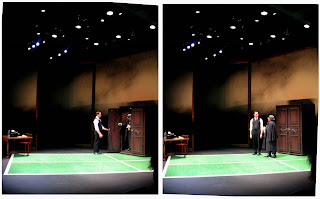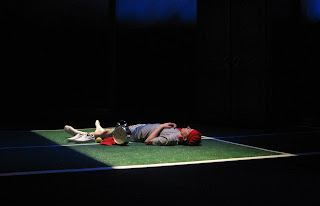
Watch it if you take the 5pm Chinatown bus to D.C.; it will not get you there quite on time for the curtain call of Hell Meets Henry Halfway. You also might read up on Polish dissident Gombrowicz. His texts were the conceptual bedrock for the two most forceful performances at the 2006 and 2007 Fringe Festivals (performed by Dada von Bzudulow Theater). Philly all-stars Pig Iron Theater Company also fed on Gombrowicz while they developed this piece, which won an Obie in 2004 and is being revived through March 1st at the Wooly Mammoth Theater in D.C.

Dito and James have each been told, by those who’ve followed Pig Iron’s trajectory [e.g. 2006’s ‘Love Unpunished’, which billed itself as a ‘movement theater evacuation’], “I’m surprised — you’ve done a proper play.” This is not quite the case. I paraded these characters for you because synopsis is not possible. Yes, we can say that some Polish bourgeoisie are holed up in castle somewhere and they awaken the potential to self-destruction that underlies all gentility. But it wasn’t until intermission and I read the dramaturge’s essay (the playbill contains no synopsis either) that I grasped more. She calls Hell Meets Henry “a theatrical mixtape — 1/3 Gombrowicz, 1/3 Pig Iron, and 1/3 Adriano Shaplin [the collaborating playwrite.] I still know nothing of Gombrowicz, but I made the connection to those Fringe performances (‘Several Witty Observations a la Gombrowicz’ & ‘Factor T’) — there, something bigger than dance was transpiring, something conjuring a raw urgency of the human condition. But unlike the bleakness of Beckett, where tramps WITHER in the face of nothingness, here, individuals in immaculate costume play out the tensions of desire and power, a more active approach to the perplexities below the surface.
Prior to intermission, my frame of reference was vague memories of Ibsen, Gorky — plays which indulge the bourgeoisie in the angst of their boredorm, while shackeled up in summer houses on the cusp of Russia’s revolution. But if this latter genre critiqued the high drama of aristocratic themes, then Hell Meets Henry is a critique of the critique — turning absurdity on the self-consciousness of bourgeois ennui.
Henry, for example, is reluctant caretaker for the decrepit hunchback prince (played, with lush Argentinien accent, by the female Bel Garcia) feeding him, ignoring his hollering, assisting him at the toilet, and finally snapping, “what else are you supposed to — you wipe asses & inherit money, it’s the world’s oldest profession.” His emotionless detachment (recall Ari Fleisher’s thin veil of cool while conducting White House press conferences) deflects most of Maya’s attacks, including the suitcases she hurls at him — she is a caged coquette, intent on spreading her misery. Meanwhile, Dr. Hincz, the humbug in the trenchcoat, paces in and out and forebodes through priceless turns of phrase. “Are you ill, Dr. Hincz?,” they ask — “I handle dark matter daily, Mr. ____. Until chaos is restored, I will always be ill.”

For Pig Iron, serious theater is never to forget the theatrics. Hence, James (the ball boy) lies motionless on stage through intermission, then jumps up, scampers, produces a giant alarm clock, and whispers loudly “Match time!” Each time the armoire is rotated, the actors make a show of kicking off the wheel-locks. Tennis balls pop spontaneously out of drawers. Pig Iron is steeped in the traditions of physical theater, and you can feel in the vigor of angst in ordinary movements. (I’d have loved to see Henry struggle with the prince in pantomime of assisted excretion. They would surely convey it with grace, just as they managed not to make schlock out of Sept. 11th in ‘Love Unpunished’.)
As the play pushes onward, humorous absurdity breaks down into the absurdity of existence — and, therefore, of death. Walchak and Maya wander out the castle, bickering meanly, and climb a strange tree — leaves a puff of gold foil, oriental-esque — and snap the neck of a squirrel. Blood spurts on faces. As they screech at each other, they copulate. Then, for the first time in the history of the play, a tennis match begins. And finally, entirely unexplained, the effete Walchak bludgeons the ballboy to death.

Hell Meets Henry is tough to get. Like all good artworks and theater, it crystallizes many iterations of a creative process, and compresses months of work into one show. It would grow on you if you could see it twice. The dramaturge’s essay proposes that not knowing any of the literary influences might prepare you best, but again, I disagree. Speaking of the secret floor where Dito keeps the prince cloistered, Dr. Hincz comments ominously “there are many secrets…the men who built these walls often sought to satisfy artistic rather than architectural ambitions.” Hell Meets Henry, I think, blends structure the two, but for me, the art outweighed the structure. I’d like to know more — what’s tennis got to do with Polish avant-garde? And why was Gombrowicz left out of my education?The play runs through this weekend. Hop on the Chinatown bus and make a theater pilgrimage. And if you do, this review spoils nothing of the play; the performance itself is much more important than the narrative.





